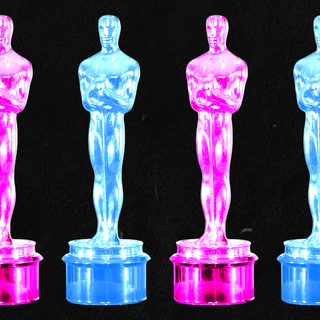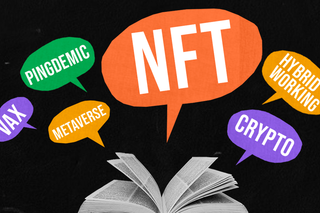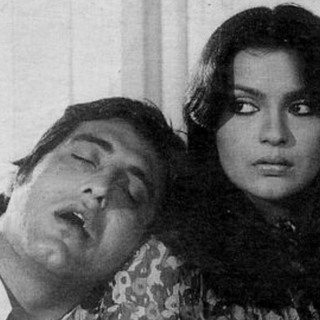
A Dictionary Picked ‘NFT’ as 2021’s Word of the Year
From “metaverse” to “pingdemic,” our shared vocabulary is growing familiar with tech and Gen Z trends.

Who would have thought “fungible” would be a popular word in 2021? The rapid rise of non-fungible tokens (NFT) is the story everyone knows well, but understands only vaguely. But it has transformed our cultural conversation — carving a decently-sized niche for itself there. Perhaps, that’s why the Collins Dictionary named “NFT” as its “word of the year” on Wednesday.
Unless you have been living under a rock — which would be completely understandable given the apocalyptic state of world affairs (climate change, pandemic, the “crisis fatigue” it can cause) — you have quite possibly heard of NFTs. If, like me, you googled it to understand what the fuss was all about, you would have learned they’re a sub-culture in cryptocurrency that allows people to claim ownership of digital artwork.
Reportedly, there was an 11,000% rise in the usage of the term in 2021. “It’s unusual for an abbreviation to experience such a meteoric rise in usage,” Alex Beecroft, managing director of Collins Learning, said.
That NFT is the most widely-recognized word of 2021 is telling of a cultural shift. The NFT wave comes in the background of a rising interest in cryptocurrency. Out of the top 10 words, two included “metaverse” and “crypto.” With Disney and Facebook — some of the largest, most renowned companies around the globe — announcing their metaverse plans earlier this year, no wonder the word made it to the list.
Evidently, our vocabulary is beginning to reflect just how much individual aspirations of digital life are changing.
“The metaverse is a logical extension of our digital lives: one marked by NFTs, cryptocurrencies, hybrid offices, online social communities, video calls. These social experiences are visceral and real just as physical interactions; most of our time is now spent in digital spaces,” Saumya Kalia wrote in The Swaddle earlier this month. Unsurprisingly, given the prominent “tech”-theme of the “Collins’ Top 10,” words like “crypto” and “hybrid working” made it to the list as well.
Related on The Swaddle:
From Cat Memes to LeBron James’s Dunks, NFT Art Is Selling At Record Prices. But What Is It?
NFTs have been around since 2014, but ever since the NFT-trend started gaining prominence earlier this year. “NFTs seem to be everywhere, from the arts sections to the financial pages and in galleries and auction houses and across social media platforms. Whether the NFT will have a lasting influence is yet to be determined, but its sudden presence in conversations around the world makes it very clearly our word of the year,” Beecroft added.
In India, too, Hindi cinema figures like Sunny Leone, Amitabh Bachchan, Salman Khan, and Manish Malhotra have begun riding the NFT wave — by launching their own lines of digital collectibles. Cricketers Zaheer Khan, Rishabh Pant, and Dinesh Karthik too jumped on the bandwagon selling digital renditions of their iconic moments on and off the field.
“One day soon, we’ll be hanging NFTs on the walls of our digital homes and buying Balenciaga tops for our digital selves,” an article in The Vanity Fair, describing the metaverse, a virtual world that we appear to be moving towards.
The fact that all of it is happening while the legal framework around NFTs continues to be uncertain in India, speaks to the meteoric rise of this artform. However, lawyers have already begun their foray into the NFT-landscape. It is, perhaps, only a matter of time before legislators find a way to regulate what appears to be a new business domain.
Besides tech, another noticeable theme the list reflects is Gen Z-terminology. Its inclusion of words like “cheugy” – an adjective used to mockingly describe someone for being “uncool,” or “trying too hard to be trendy. Even “regencycore,” a “fashion aesthetic inspired by the Georgian-era clothing” seen on Netflix’s hit show Bridgerton attest to the assimilation of Gen Z-lingo into our collective consciousness.
Related on The Swaddle:
In the meantime, we’re caught in the middle of a global health crisis with experts suggesting India may face the third wave in December. As such, it was almost impossible for our pandemic vocabulary to not feature on the list. And, well, the impossible didn’t happen. Words like “double-vaxxed,” or “having received two vaccinations against a disease;” and “pingdemic,” or the “the large-scale notification of members of the public by a contact-tracing app” also found their way. Last month, “vax” was declared Oxford English Dictionary’s “word of the year.”
Further, in what seems to be a positive development, words like “climate anxiety” and “neopronoun” are on the list too. Why is their inclusion positive? Well, one suggests we’re beginning to genuinely worry about the consequences human actions have had on the climate — providing hope (at least, to me) that we’re beginning to take the problem seriously.
And the popularity of “neopronouns,” or pronouns “designed to avoid gender distinctions,” suggests we’re on our way to a world — or metaverse — where we can learn to think outside the (gender) box.
“Collins’ Top 10” this year is very telling of how our language is constantly evolving to keep up with the pace of our collective sentiments. And by analyzing our vocabularies, the list reflects the evolution and trajectory of these sentiments too.
Let’s raise our glasses to a more inclusive world, shall we?
Devrupa Rakshit is an Associate Editor at The Swaddle. She is a lawyer by education, a poet by accident, a painter by shaukh, and autistic by birth. You can find her on Instagram @devruparakshit.
Related


‘Tick, Tick… BOOM!’ Is a Tragedy About Time, but It Doesn’t Ask Who Gets To Have It
